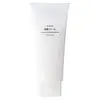Muji Mild Face Soap Versus Muji Moisturising Milk
What's inside
What's inside
 Benefits
Benefits

 Concerns
Concerns

 Ingredients Side-by-side
Ingredients Side-by-side

Water
Skin ConditioningMyristic Acid
CleansingButylene Glycol
HumectantStearic Acid
CleansingPotassium Hydroxide
BufferingGlycerin
HumectantPalmitic Acid
EmollientGlycol Distearate
EmollientLauric Acid
CleansingSodium Lauramido Diacetate
CleansingSodium/Mea-PEG-3 Cocamide Sulfate
CleansingCitrus Aurantium Dulcis Fruit Extract
MaskingOlea Europaea Fruit Oil
MaskingSorbitan Stearate
EmulsifyingLauramide DEA
Water
Skin ConditioningDipropylene Glycol
HumectantGlycerin
HumectantEthylhexyl Palmitate
EmollientPEG-32
HumectantSqualane
EmollientPentylene Glycol
Skin ConditioningPEG-40 Hydrogenated Castor Oil
EmulsifyingGlycosyl Trehalose
Emulsion StabilisingHydrolyzed Starch
HumectantPortulaca Oleracea Extract
Skin ConditioningOlea Europaea Fruit Oil
MaskingPolyquaternium-51
Skin ConditioningCitrus Grandis Seed Extract
AstringentArginine
MaskingAllantoin
Skin ConditioningXanthan Gum
EmulsifyingCarbomer
Emulsion StabilisingButylene Glycol
HumectantSodium Citrate
BufferingPhenoxyethanol
PreservativeWater, Dipropylene Glycol, Glycerin, Ethylhexyl Palmitate, PEG-32, Squalane, Pentylene Glycol, PEG-40 Hydrogenated Castor Oil, Glycosyl Trehalose, Hydrolyzed Starch, Portulaca Oleracea Extract, Olea Europaea Fruit Oil, Polyquaternium-51, Citrus Grandis Seed Extract, Arginine, Allantoin, Xanthan Gum, Carbomer, Butylene Glycol, Sodium Citrate, Phenoxyethanol
 Reviews
Reviews

Ingredients Explained
These ingredients are found in both products.
Ingredients higher up in an ingredient list are typically present in a larger amount.
Butylene Glycol (or BG) is used within cosmetic products for a few different reasons:
Overall, Butylene Glycol is a safe and well-rounded ingredient that works well with other ingredients.
Though this ingredient works well with most skin types, some people with sensitive skin may experience a reaction such as allergic rashes, closed comedones, or itchiness.
Learn more about Butylene GlycolGlycerin is already naturally found in your skin. It helps moisturize and protect your skin.
A study from 2016 found glycerin to be more effective as a humectant than AHAs and hyaluronic acid.
As a humectant, it helps the skin stay hydrated by pulling moisture to your skin. The low molecular weight of glycerin allows it to pull moisture into the deeper layers of your skin.
Hydrated skin improves your skin barrier; Your skin barrier helps protect against irritants and bacteria.
Glycerin has also been found to have antimicrobial and antiviral properties. Due to these properties, glycerin is often used in wound and burn treatments.
In cosmetics, glycerin is usually derived from plants such as soybean or palm. However, it can also be sourced from animals, such as tallow or animal fat.
This ingredient is organic, colorless, odorless, and non-toxic.
Glycerin is the name for this ingredient in American English. British English uses Glycerol/Glycerine.
Learn more about GlycerinOlea Europaea Fruit Oil is the fixed oil obtained from the ripe fruit of the Olive. In other words - olive oil.
The primary contents of olive oil are glycerides of the fatty acids linoleic, oleic and palmitic.
Olive oil also contains antioxidants such as Vitamin E. Antioxidants may help reduce signs of aging by fighting unstable free-radical molecules. It also contains Vitamins A (retinol), D, and K.
The squalene in olive oil makes it a great emollient. Emollients help soothe and soften your skin by trapping moisture in. This makes olive oil a great skin moisturizer.
Studies show olive oil to have antibacterial and antifungal properties in low concentrations. Another study found olive oil irritated sensitive oily skin. We always recommend speaking with a professional about using this ingredient in your routine.
Due to the fatty acid content, this ingredient may not be fungal-acne safe.
Learn more about Olea Europaea Fruit OilWater. It's the most common cosmetic ingredient of all. You'll usually see it at the top of ingredient lists, meaning that it makes up the largest part of the product.
So why is it so popular? Water most often acts as a solvent - this means that it helps dissolve other ingredients into the formulation.
You'll also recognize water as that liquid we all need to stay alive. If you see this, drink a glass of water. Stay hydrated!
Learn more about Water